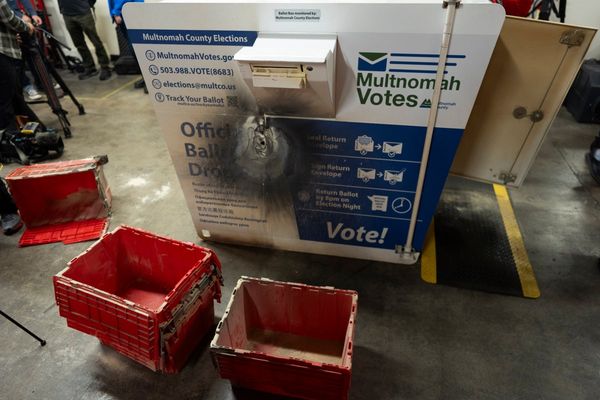
On July 23, U.S. Secretary of State Mike Pompeo gave a major address on China that received widespread attention. The speech contained much to commend, but it was missing an important element: It did not articulate a clear goal of the U.S. strategy for China.
The 2017 U.S. National Security Strategy declared that the return of great-power competition with China and Russia was the foremost threat facing the United States, but Washington has yet to articulate a clear objective for this competition, and many questions about its nature remain unanswered.
What are the United States and China competing for? When will the competition end? What does success look like?
A good strategy includes a clear statement of one’s goals and a plan for achieving them. And in order to compete with China’s broadening economic and geopolitical ambitions, the United States needs to articulate a clearer end game for this competition and a corresponding strategy for arriving there.
For most of the period since the end of the Cold War, the United States’ goal vis-à-vis China was clear: to make Beijing a “responsible stakeholder” in the U.S.-led rules-based international system. The theory was that by enmeshing China into the already established global institutions and trade links, China would eventually grow rich, democratize, and cooperate with the rest of the international community. Basically, the goal was to make China the Germany of Asia.
It was a coherent approach, but it didn’t work. China has become rich, but instead of moderating its behavior, it has grown more assertive and confrontational. Contrary to hopes that China would democratize, President Xi Jinping has set himself up as China’s most powerful dictator since Mao Zedong.
He has eliminated term limits so that he can rule indefinitely. He is cracking down on human rights in Hong Kong and engaging in ethnic cleansing in Xinjiang against the country’s Uighur community. Beijing is also engaging in “sharp power” practices against democracies and exporting surveillance technology to other authoritarian regimes and generally promoting autocratic states abroad.
Rather than acting as a responsible stakeholder, China continues to prey on the global economic system. It provides subsidies to its own companies, conducts widespread intellectual property theft, restricts market access to foreign companies, and engages in many other unfair economic practices.
Perhaps most threateningly, China is also flexing its military muscle. It has invested heavily in its military capabilities, steadily shifting the balance of power in Asia to the point that U.S. defense planners openly worry whether Washington can still defend long-standing partners in the region, such as Taiwan.
It is beginning to show global security ambitions by building new bases overseas and conducting military exercises in Europe. As the international community shows a reluctance to confront China head-on, Beijing has felt increasingly emboldened, using its newfound clout to coerce its neighbors, planting its flag on contested territory in the South China Sea and India.
There is little reason to think China’s assertiveness will be reversed on its own, and this seems to have convinced Washington and much of the world that the old strategy has failed. But the United States has come up short in its efforts to articulate a new set of goals for a new era.
In addition to the aforementioned National Security Strategy, the 2018 U.S. National Defense Strategy also prioritized the return of great-power competition against China. But recognizing that competition exists is not a strategy. Neither document provided a clear objective or set of objectives for the United States and its allies. Without clear objectives, it is hard to know whether the steps called for in these strategy documents actually advance the U.S. position.
Few changes have taken place since then. The White House released a new China strategy in May, and while it did provide greater detail, it still fell short. Tellingly, it stated explicitly that the U.S. approach “is not premised on determining a particular end state for China.”
In my conversations with senior Trump administration officials, I have also received conflicting and sometimes incoherent answers to my questions about the end goal of their China strategy. One said: “There is no goal. Countries have always competed, and it will never end.” But this obscures the reality of the situation. Although some form of interstate rivalry has always existed in international relations, the United States hasn’t always been in competition with China, and the current rivalry cannot last. And no one seriously wants to engage in endless competition with China.
Another senior official went one step further, saying that the goal was simply to avoid the outbreak of a major conflict between the two while maintaining a level of competition. When asked if it would be a success if war was averted but China was able to undermine U.S. interests and establish a sphere of influence throughout the Indo-Pacific and beyond, he acknowledged he needed to rethink his answer.
And these were the rare officials with the confidence and ability to articulate a clear answer. Most are unable or unwilling to express the goals of great-power competition. To be fair, defining goals is hard. But the reality remains that the Trump administration and the U.S. national security community do not yet have a clear goal for competition with China.
The problem becomes easier to parse if one distinguishes between short- and long-term goals. Washington’s long-term objective should be to have a cooperative relationship with China. The post-World War II rules-based international system, designed by the United States and its allies, has led to unprecedented levels of peace, prosperity, and freedom for the world. That system will function best if China (the world’s second-largest military and economic power) is a constructive member and is not actively trying to tear it down.
In a sense, U.S. policymakers have known this to be the correct end state for decades. This is what they envisioned when they talked about making China a responsible stakeholder. The problem is that this scenario is impossible to actualize with Xi as president and the current generation of Chinese Communist Party (CCP) leadership in power. They are determined to launch China on a new and more assertive course.
To achieve these long-term objectives, then, policymakers will need to convince the Chinese leadership to change course. This brings us to the short-term goal. Washington needs to make China’s leadership understand that challenging the United States and its democratic allies is simply too difficult and too costly. Over time, Washington can convince Beijing that its own interests are better served by playing along with the rules-based system, rather than trying to challenge it.
This will not be easy. It will likely take a generation or more until a new cohort of Chinese leaders comes to power chastened by their predecessors’ experience of unsuccessful competition with the United States and its allies.
So how could this be achieved?
First, policymakers must protect the United States, its allies, and its partners from the threats China currently poses in the security, economic, technology, and governance domains. This will require Washington to strengthen itself, its allies, and the rules-based system for this new era of competition.
Necessary steps include reestablishing a favorable military balance of power in the Indo-Pacific; placing tougher restrictions on foreign investments into sensitive areas of their economies; investing and becoming a leader in the development of the technologies of the 21st century, including artificial intelligence; reclaiming leadership of multilateral institutions; and creating new frameworks for cooperation among democratic allies, such as the Quad alliance of the four leading democratic powers in the Indo-Pacific: the United States, Japan, India, and Australia. Competition is generally more about strengthening oneself than about weakening one’s opponent, and great-power politics is no different.
Second, the United States, its allies, partners, and like-minded states should impose meaningful costs on China wherever it violates international standards. This means developing coordinated approaches to punish Beijing for its misdeeds with measures that are consistent with their values but also strike at its vulnerabilities. This should include countervailing tariffs against China’s unfair economic practices, targeted sanctions in response to China’s human rights violations, and calibrated uses of military force to counter Chinese military aggression. Some may see this element as risky or confrontational, but it will be necessary to convince Chinese leaders that challenging the United States and its allies is too costly.
Finally, Washington must signal to Beijing that there is a pathway to long-term cooperation that is beneficial to both sides and to the world. There should be an engagement track. The United States and its allies should have meaningful dialogue with Beijing in forums such as the G-20. This will allow them to collaborate with Beijing now on areas of mutual interest, such as arms control, nuclear nonproliferation, environmental policy, and coordinated economic measures to help the world recover from the coronavirus-induced global recession.
But, more importantly, it will demonstrate to the Chinese leadership that Washington and its allies are serious about cooperation if and when Beijing can be serious about abiding by international rules. This element may be contrary to the prevailing political climate in Washington and the desire to get tough on China, but it is critical.
Critics might contend that China is a rising power and the United States and its allies no longer have the capacity to implement such a strategy. But China possesses only 15 percent of global GDP, compared with 59 percent for the United States and its formal treaty allies. Add other democracies to the ledger and the latter figure increases to 75 percent. Working together, the free world still possesses the preponderance of power necessary to decisively shape international outcomes.
Some might argue that this strategy is a veiled call for regime change in China, but that is not true. This goal can be accomplished if and when a more cooperative Chinese leadership comes to power in Beijing, whether or not it stands behind the CCP banner.
Washington and its allies cannot afford strategic uncertainty as they confront their most serious geopolitical rival in decades. They are on the starting blocks ready to race, but they do not yet know where the finish line is. The above strategy could help point them in the right direction.







